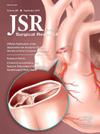Nerve Blocks in Reduction Mammaplasty: A Systematic Review and Meta-Analysis of Pain Outcomes
IF 1.7
3区 医学
Q2 SURGERY
引用次数: 0
Abstract
Introduction
Postoperative pain can delay recovery following reduction mammaplasty (RM). While nerve blocks (NBs) are widely used in other surgeries, their efficacy in RM remains underexplored. This study evaluates the impact of perioperative NB on pain management and opioid use after RM.
Methods
A systematic review was performed per Preferred Reporting Items for Systematic Reviews and Meta-Analyses guidelines. Pubmed, Embase, SCOPUS, and Cochrane databases were queried for studies on NB in RM. NB type and outcomes, including postoperative pain, opioid consumption, and rescue analgesia, were extracted. Meta-analysis was performed using a random-effects model and inverse-variance methods to calculate mean differences (MDs).
Results
Seven studies with 330 patients were included, of whom 53.6% (n = 177) received NB. Six studies used saline negative controls, and one compared drug compositions. NB significantly reduced postoperative pain at 1 h (MD −2.00, P < 0.001), 4 h (MD −1.86, P < 0.001), 6 h (MD −2.13, P = 0.005), and 12 h (MD −1.89, P < 0.001), but not at 24 h (MD −0.78, P = 0.12). NB also reduced intraoperative (MD −8.51, P = 0.02) and 24-h postoperative opioid use (MD −7.55, P < 0.001). The need for rescue analgesia was reduced by 96% following NB (odds ratio 0.04, P < 0.001). No difference in pain reduction at 1 h was found between NB types (P = 0.81, I2 = 0%).
Conclusions
NBs significantly reduce early postoperative pain and opioid use in RM, with no differences observed between NB types.
缩乳术中的神经阻滞:疼痛结果的系统回顾和荟萃分析。
简介:术后疼痛会延迟乳房缩小成形术(RM)后的恢复。虽然神经阻滞(NBs)广泛应用于其他手术,但其在RM中的疗效仍未得到充分探讨。本研究评估围手术期NB对RM术后疼痛管理和阿片类药物使用的影响。方法:根据系统评价和荟萃分析指南的首选报告项目进行系统评价。检索Pubmed、Embase、SCOPUS和Cochrane数据库,查找RM中NB的相关研究。提取NB类型和结果,包括术后疼痛、阿片类药物消耗和抢救性镇痛。采用随机效应模型和反方差方法进行meta分析,计算平均差异(MDs)。结果:纳入7项研究330例患者,其中53.6% (n = 177)接受NB治疗。六项研究使用生理盐水阴性对照,一项比较药物成分。NB在术后1 h (MD -2.00, P < 0.001)、4 h (MD -1.86, P < 0.001)、6 h (MD -2.13, P = 0.005)和12 h (MD -1.89, P < 0.001)显著减轻了术后疼痛,但在24 h (MD -0.78, P = 0.12)没有显著减轻疼痛。NB还减少了术中(MD -8.51, P = 0.02)和术后24小时阿片类药物使用(MD -7.55, P < 0.001)。NB后患者对镇痛的需要减少96%(优势比0.04,P < 0.001)。两种NB在1 h疼痛减轻方面无差异(P = 0.81, I2 = 0%)。结论:NB可显著减少RM术后早期疼痛和阿片类药物使用,不同NB类型间无差异。
本文章由计算机程序翻译,如有差异,请以英文原文为准。
求助全文
约1分钟内获得全文
求助全文
来源期刊
CiteScore
3.90
自引率
4.50%
发文量
627
审稿时长
138 days
期刊介绍:
The Journal of Surgical Research: Clinical and Laboratory Investigation publishes original articles concerned with clinical and laboratory investigations relevant to surgical practice and teaching. The journal emphasizes reports of clinical investigations or fundamental research bearing directly on surgical management that will be of general interest to a broad range of surgeons and surgical researchers. The articles presented need not have been the products of surgeons or of surgical laboratories.
The Journal of Surgical Research also features review articles and special articles relating to educational, research, or social issues of interest to the academic surgical community.

 求助内容:
求助内容: 应助结果提醒方式:
应助结果提醒方式:


